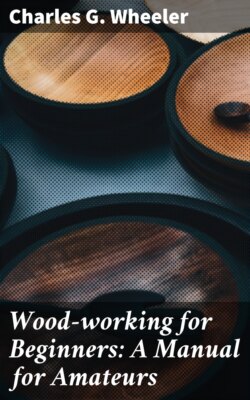Читать книгу Wood-working for Beginners: A Manual for Amateurs - Charles G. Wheeler - Страница 16
На сайте Литреса книга снята с продажи.
CHAPTER VI
ARTICLES TO BE MADE IN THE WORKSHOP
ОглавлениеTable of Contents
Even if you are able to use tools quite well, you may still not know how to go to work to make some particular thing, so it is quite important to know how to lay out, put together, and finish different kinds of work.
The number of things you can make is legion. The number it is worth while for you to make is much smaller. Amateurs often say that the work they do themselves costs more (even counting their own labour as nothing) than to hire the work done, and it is one aim of this book to prevent that undesirable result, in some cases at least.
The number of things which you can make more cheaply than you can buy grows smaller every year. Many things can now be bought ready-made for less than you would have to pay for the materials. It is foolish to take the time and money to make many of the games and toys, for instance, sold so cheaply nowadays. A wheelbarrow is in itself a good thing to make, but it can be bought so cheaply that it is hardly worth while to make one. It is true that some of these things you can make better, although not cheaper, than you can easily buy (a sled perhaps); but, as a rule, your time can be better spent than upon this class of objects, and you will find but few such given here.
Things like whistles, pea-shooters, and clappers, which are so familiar to every boy and require no more instruction to make than is handed down and around from boy to boy, are not given here, as a rule. A few other things which you might perhaps look for, such as tennis rackets and snow-shoes, are omitted, because they require more special knowledge and skill than most beginners can be expected to have. It is easy enough to see how to make a tennis racket, for instance, so far as the general idea is concerned; but simply bending a loop, fastening it to a stick, and lacing the loop, does not make a tennis racket. The holes for the stringing must be made in a particular way, the stringing must be done properly, and the whole affair must balance or "hang" right, or be of little use. It is better to buy such things.
You boys, and many of your elders, like to try all the new-fangled ideas as fast as they come out, and it is well that you do, but you (as a class) accept them "for keeps" only after they have stood the test of many trials. A large book could be filled with descriptions of the novelties which have appeared within my remembrance, but out of this number I can count on my fingers all that have come to stay. You will find all the novelties you can attend to (and more) in the magazines, etc., so I have been rather conservative in my selection, knowing that you will permanently accept but the best of the new ideas and come back in the end, year after year, to the same old things, with only such additions as have stood the test of actual use.
The objects included embrace a sufficient variety of types to form a basis of experience and practice, in different kinds of work and in various details, from which you can launch out into any of these new plans, or any experiments of your own which you may wish to try, and thus supply for yourselves the information lacking in many of the popular descriptions.
Before you make anything bulky measure your shop door or window to see that you can get it out after you have made it. This may seem a superfluous caution, but there have been many cases where people have spent much time in making things which could not be taken from the room in which they were made without tearing out the door or window casing. Even Robinson Crusoe, you know, built a boat so far from the water that he could not launch her.
Do not be deceived by all the complicated, new-fangled variations of familiar things which abound in the popular publications. Try to make everything as simple as you can. Look askance on contrivances that are all tangled up with springs, and levers, and complicated mechanism, and study them well before you begin to make them.
First figure the cost of the object you intend to make. This book is not to do your work for you, but to put you on the right track to do it yourselves, so read Estimating, page 54, and the whole of Part I had best be read before you begin to make the things described hereafter.
